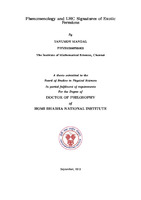- DSpace Home
- →
- IMSc Theses/ Dissertations
- →
- IMSc Theses/ Dissertations
- →
- View Item
JavaScript is disabled for your browser. Some features of this site may not work without it.
| dc.contributor.author | Tanumoy Mandal | |
| dc.date.accessioned | 2016-03-02T07:32:09Z | |
| dc.date.available | 2016-03-02T07:32:09Z | |
| dc.date.issued | 2013 | |
| dc.date.submitted | 2013 | |
| dc.identifier.uri | https://dspace.imsc.res.in/xmlui/handle/123456789/374 | |
| dc.description.abstract | In this thesis, we briefly discuss some theoretical shortcomings of the Standard Model (SM) and motivate the need for beyond the SM (BSM) physics. Many BSM extensions predict the existence of new heavy fermions with masses near the TeV scale. In this thesis we study the LHC phenomenology of two types of such new heavy fermions, namely the vectorlike quarks (VLQ) that arise in various warped extra-dimensional theories, and the color octet electrons (COE) that appear in some quark-lepton compositeness models. We review the construction of the original Randall-Sundrum model. We show how this model solves the gauge hierarchy problem of the SM. We also discuss how warped geometry can address the flavor hierarchy problem of the SM by allowing SM fermions into the bulk. We give the details of some warped models both without and with custodial protection of the Zbb coupling that have been proposed earlier in the literature. For each of these models we carefully work out various Lagrangian terms in the mass basis relevant to the phenomenology we discuss in the thesis. We present the parameter choices, which we use for our numerical results, for the different warped-space models. More than one heavy charge -1/3, 2/3 and 5/3 VLQs can be present in different warped-space models, and they can mix among themselves and the SM quarks. We explore the pair production channel for discovery of the new VLQs. However, in addition to pair production, we also look into some of their important single production channels since single production processes can give useful information about the electroweak nature of the underlying models. We compute the discovery luminosity and reach of the different VLQs at the LHC. We discuss the LHC phenomenology of COE in an effective theory framework. We briefly discuss various preonic models of quark-lepton compositeness in which COE are present. We display the interaction Lagrangian of a generic COE and decay width of COE for different choice of compositeness scale. We have identified a new set of single production diagrams whose contribution is comparable to other dominant production channels of the COE. In a realistic computation, after parton showering and hadronization, it is very difficult to separate different production processes from each other. We implement a search method where the signal is a combination of pair and single production events. This method has potential to increase the LHC reach significantly. We compute the discovery lumonosity and reach of the COE at the LHC. | en_US |
| dc.publisher.publisher | The Institute of Mathematical Sciences | |
| dc.subject | Phenomenology | en_US |
| dc.subject | LHC Signatures | en_US |
| dc.subject | VectorLike Quarks | en_US |
| dc.subject | HBNI Th66 | en_US |
| dc.title | Phenomenology and LHC signatures of Exotic Fermions [HBNI Th66] | en_US |
| dc.type.degree | Ph.D | en_US |
| dc.type.institution | HBNI | en_US |
| dc.description.advisor | Shrihari Gopalakrishna | |
| dc.description.pages | 121p. | en_US |
| dc.type.mainsub | Physics | en_US |
| dc.type.hbnibos | Physical Sciences |
Files in this item
This item appears in the following Collection(s)
-
IMSc Theses/ Dissertations
IMSc Theses/ Dissertations
